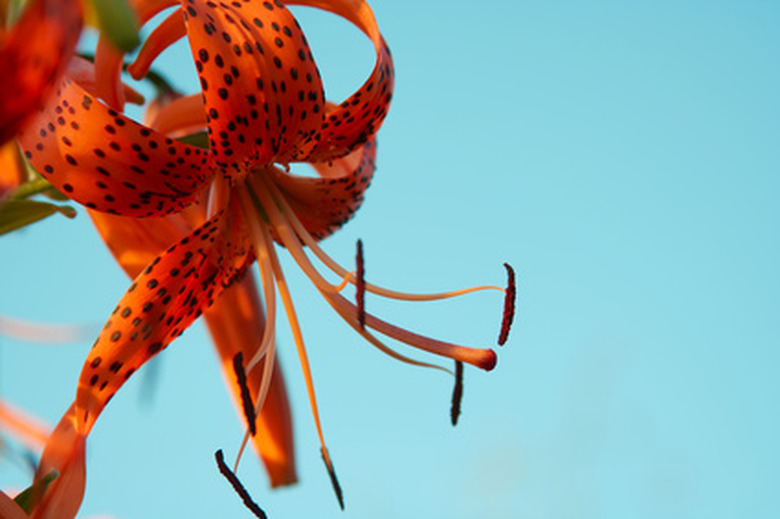Name The Parts Of The Tiger Lilly
"The panthers of the meadow–tiger lilies," a quote from writer Titus Munson Coan, offers a description as colorful as the flower. Tiger lilies sport large, fiery orange blooms speckled with dark spots, much like freckles on skin.
"The panthers of the meadow–tiger lilies," a quote from writer Titus Munson Coan, offers a description as colorful as the flower. Tiger lilies sport large, fiery orange blooms speckled with dark spots, much like freckles on skin. Other names for Tiger lilies include Devil lily, Leopard lily, Chalace-cup lily and Pine lily. Another popular name, Ditch lily, was given because these flowers populate ditches throughout the United States. This bloom displays distinctive parts and characteristics.
Bulb
The bulb part of the Tiger lily is the underground shoot and has modified leaves with thickened leaf bases that the flower uses as food storage.Tiger lilies grow easily, thus they make hearty garden plants. Because they grow so effortlessly, bulb scales can be removed or peeled off the bulb and planted in peat soil in a cool dark place. These will produce bulbets that can grow in a nursery environment and be planted outside.
- "The panthers of the meadow–tiger lilies," a quote from writer Titus Munson Coan, offers a description as colorful as the flower.
- Because they grow so effortlessly, bulb scales can be removed or peeled off the bulb and planted in peat soil in a cool dark place.
Petals
Also called the corolla, Tiger lily petals come in showy, vibrant orange. They also sport dark freckle-like spots. Petals surround the reproductive parts of the bloom. Since Tiger lily petals come in multiples of three, they are classified as monocots.
Stamens
As the Tiger lily develops and the petals curl, the flower reveals six whitish-yellow stems sticking out of the center, called stamens. Anthers rest on the end of each stamen.
Anthers
Anthers carry the all-important pollen that flowers use to reproduce. The rust-colored anthers on Tiger lilies contain pollen dust that should be carefully handled, because if it brushes up against clothing, it can leave a stain that is hard to remove.
- Also called the corolla, Tiger lily petals come in showy, vibrant orange.
- The rust-colored anthers on Tiger lilies contain pollen dust that should be carefully handled, because if it brushes up against clothing, it can leave a stain that is hard to remove.
Leaf Axil
Leaf axils fill up with water and form habitats. This part of the flower is deep and can hold water. It's where the leaf attaches to the stem. Leaf axils can hold 1.5 centimeters to 166.9 centimeters of water, according to Oracle ThinkQuest Education Foundation.
Stem
Inflorescence–the budding process–occurs in the Tiger lily's flower stem. Buds grow into one or more flowers. The stem is divided into internodes and nodes, which hold the buds. Tiger lilies typically grow four to five flowers on each individual stem.
- Leaf axils fill up with water and form habitats.
- The stem is divided into internodes and nodes, which hold the buds.
Pistil
Tiger lilies contain a single pistil–a basal portion that is also referred to as the ovary of the flower because it contains embryo seeds or ovules. It also houses the stigma and style. The sticky part, the stigma at the top of the pistil, traps and holds pollen. The style, the tube-like structure, supports the stigma.
